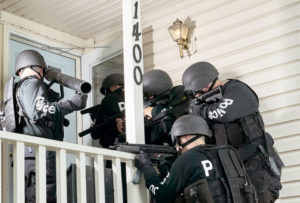
You have a natural born right to self-defense. The Second Amendment guarantees it. But as we move into 2019, gun control advocates at both the state and federal level are coming for your guns.
Are you familiar with a “red flag” order? “Every state has a slight variation in standards, but in general these confiscation laws allow courts to issue emergency ex-parte orders based on the lowest ‘reasonable cause’ evidence that the subject is an immediate danger to himself or others,” writes Kelley Vlahos at The American Conservative.
Fourteen states, including D.C., have some version of a red flag bill where, if police, health care officials, spouses, family, and those a person might be dating and/or cohabiting with believe you’re a danger to others—they can confiscate your guns, explains Vlahos. No due process or ex-parte. You aren’t there to make your case (no due process) when they meet with the judge to obtain a “no knock” warrant. See any problems here?
And forget about getting your guns back considering it would take that same judge to admit he was in the wrong for you to get them back. This is a Michael Bloomberg-style dream scenario to slowly take away your natural born right to self-defense. And this is only the beginning.
As I wrote to you here, it’s the foundation for a rule by mob society that we’re witnessing in Latin America by example.
You can read more from Vlahos below:
Critics are also concerned that, because several states allow people beyond police and family to petition the court—ex-spouses, boyfriends and girlfriends—the law might encourage false claims and anti-gun snitching in today’s hyper-“say something, see something” culture. While some of the state and pending federal laws penalize erroneous charges and abuse, the immediate damage to a person’s legal status and reputation could be irrevocable.
“This is a domestic retribution act, that is what they should call it,” said Dudley Brown, head of the National Association of Gun Rights, which is firmly against any red flag laws. “Anyone who has been in a divorce or custody battle should cringe when they hear this.”
Whether extreme danger protection laws actually work is a matter of faith for the most part. The earliest laws in Connecticut (1999) and California (2014) were passed after mass shootings in which the killers left bread crumb trails but police apparently did not have the authority to confiscate their guns before the crimes were committed (in both cases, the perpetrators stabbed and shot their victims).
Unfortunately, the new Connecticut law did not prevent the deadliest school shooting in state history—the 2013 elementary school massacre in Newtown, during which 28 people (mostly children) were gunned down by 20-year-old Adam Lanza. Lanza’s mother, who he also killed in the rampage, owned the guns he used, and the police had no sense that he was a threat until it was too late.
Nor did the law prevent the most recent mass shooting in Thousand Oaks, California, during which 12 people inside a bar were killed by Evan Long, a U.S. Marine Corps veteran. Reason‘s Jacob Sullum doubts it could have prevented even the Parkland massacre.
Proponents however, insist that red flag laws have prevented domestic violence and high school shootings, and especially suicides. A 2016 study in Connecticut found that for every 10 to 20 guns seized under the law, one suicide was prevented. Another claims there were 7.5 percent fewer gun suicides in Indiana in the decade following that state’s own red flag law in 2005.
Interestingly, the National Rifle Association, the country’s largest pro-firearms lobby, has not entirely opposed red flag laws. In March, the NRA said in a video that it would support emergency protection orders with the condition that they include “strong due process.” “We can prevent violence and protect the Second Amendment rights of law-abiding Americans at the same time,” promised Chris Cox, the head of NRA’s lobbying arm. Around that time, President Trump quipped after the Parkland shooting that it was time to “take the guns first, go through due process second.”
Since then, the administration has said very little, and the NRA did not return repeated requests by TAC to comment on whether it would support federal measures in the upcoming session.
Meanwhile, Michael Bloomberg’s gun control initiative poured literally millions into the 2018 midterm elections, targeting Republican gun supporters in purple districts like Congressman Mike Coffman’s with negative ads. (Coffman lost his Colorado seat.) Emboldened national campaigns, backed by Bloomberg and groups like the Giffords Law Center, are behind the drafting of new state red flag laws, and are likely to play a key role in any federal gun control wave in 2019.
But don’t be fooled, say critics. These laws, sold as prevention and mental health measures, are one more step towards thwarting the Second Amendment outright.
“There is a tremendous potential for anti-gun officials to turn this into a much broader platform for confiscation,” warned Kopel, who is on a committee to make the laws more uniform, requiring higher standards of evidence and prior notice, with ex parte being the exception not the rule.
Hammond, who has been working on Capitol Hill for 30 years, mostly on gun issues, agreed: “I think the game is to incrementally tighten the noose until all states become California and New York,” which have the strictest laws against gun ownership in the country.
“My experience is in jurisdiction where they can do pretty much whatever they want they never reach a point where they say ‘this might be going too far,’” Hammond added.
Read more here.



